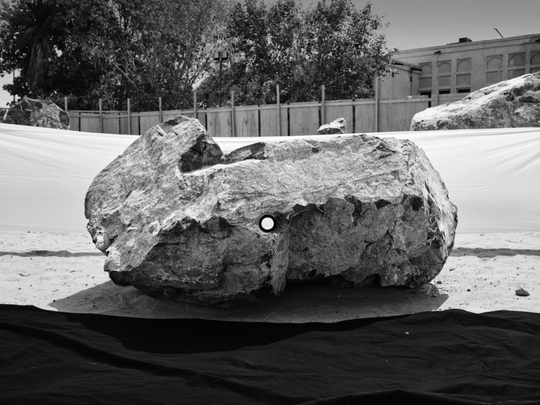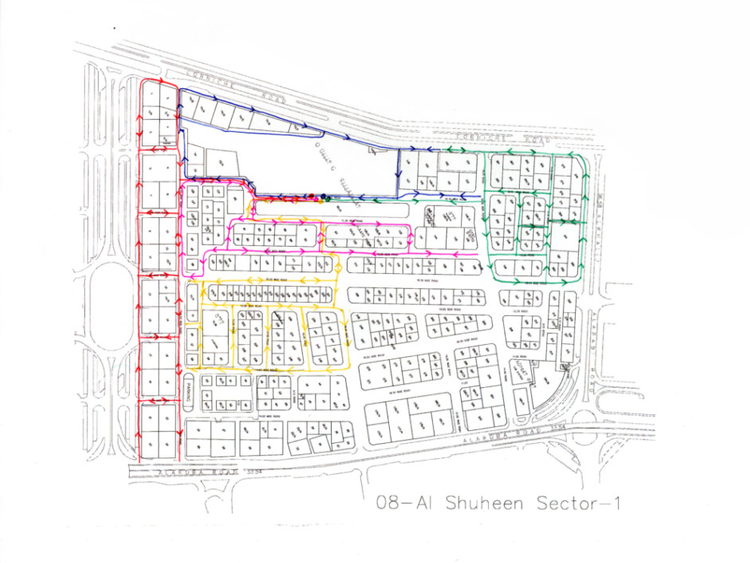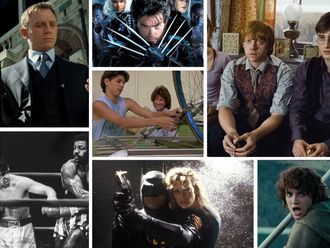
Vikram Divecha is interested in exploring the unseen layers of the systems and structures of urban life. The Dubai based Indian artist collaborates with various institutions, industries and communities, to stage interventions that highlight otherwise invisible structures and operations in their systems.
In his latest show, Minor Work, curated by Murtaza Vali, Divecha is exhibiting artworks created in collaboration with road marking crews in Dubai, municipal sweepers and gardeners in Sharjah, and a stone quarry in Fujairah. The artworks draw attention to work that seems to be minor, and often goes unnoticed and unappreciated, but is essential in the running and maintenance of a city. Through his unusual art making techniques, the artist transforms public spaces in the city into his studio, and brings the mundane, but vital tasks of ordinary workers into the realm of art, addressing complex questions of artistic authorship, appropriation, access and value.
Divecha’s Road Marking series has been done in collaboration with the crews who maintain road markings across Dubai. Some of these crews are engaged in refreshing existing road markings on busy roads, and thus work late at night, under severe time constraints.
When working with them, the artist simply inserted a set of grey rectangular boards in the rhythm of their regimented process, getting sections of the yellow lines, white arrows, and other markings they were repainting, on his boards to generate what look like minimalist, geometric, abstract paintings.
He also worked with crews marking roads in areas that were under construction, and hence free from traffic. Here the men had the time and freedom to be more creative with their brushes or machines, resulting in interesting forms and textures on the boards. The artworks transpose traces of the city’s roads, and traffic management systems into the gallery space, inviting viewers to look at their city in a different and deeper way. The titles of the artworks include details of the crews, the size and type of markings, and the areas where they were made, emphasising the connection with the city’s infrastructure and the unseen people who maintain it.
“I see this entire series as an abstract mapping of the city. It started as a simple gesture of mark making, but unlike minimalist art, which removes the hand, these formal, gestural works are like a register of the city, of a team of workers, and of my own presence during these operations,” Divecha says.
In a project from 2015, Shaping Resistance, Divecha collaborated with five municipality gardeners working in Sharjah’s Al Majaz Park. For several months, he conducted drawing workshops for them, with the aim of encouraging them to introduce their own subtle variations in the regimented hedge design of the park.
This intervention was meant to be temporary, but has now become a permanent feature of the garden. In this show, Divecha revisits the project by presenting photographs of the simple drawings the gardeners made in their sketch books, while developing their alternative hedge designs.
He gave the ‘artists’ artistic and financial stake in the work, by asking each gardener to decide which drawing he wanted to exhibit from his sketchbook, and to negotiate with the gallery the distribution of the proceeds from the sale of their works. Once again, the artist has found an interesting way to give a creative twist to mundane tasks, to recognise work that often goes unnoticed and unappreciated, and to assign value to it.
“The sketch books are a residue from the workshops I conducted, and have been lying with me for some time. Involving the gardeners in the process, and bringing them into the gallery made them realise the aesthetic and commercial value of their discarded sketch books. These works thus raise questions about commerce and ethics, and about the repositioning of the relationship between me, my gallery, and my collaborators in a commercial context,” Divecha says.
For the Sharjah Art Foundation’s March Project 2016, Divecha developed a daily performance project titled, Sweeping, which unfolded on the streets around the Sharjah Art Museum, and sought to reposition sanitation work as art practice. He replotted the daily routes of five sweepers working in the area, so that they converged at the entrance to the museum. Each sweeper deposited his green trash filled bags in a row around the entrance, resulting in a kind of art installation.
The project drew attention to the essential, but unacknowledged labour of the sweepers, and its relationship to the edifice of the museum. In this show, the artist is exhibiting a series of drawings, titled Remapped Sweeper Route, where he has marked the route taken by each sweeper with ball-point pen on a map of the area, thus giving the daily labour of the sweepers its due recognition on an official representation of the city.
“While researching this project, I walked in the streets with individual sweepers for many months, watching them as they worked alone and silently, looking down most of the time. So, this is also a mark making exercise, and a form of silent mapping of individual performers,” Divecha says.
In 2014, Divecha had created a huge public installation at the Shindagha Heritage Village, called Boulder Plot, featuring an arrangement of 24 boulders sourced from the mountain quarries of Fujiarah. The boulders were later returned for pulverising in a crusher plant to create aggregate for construction.
The artist had carefully selected boulders that retained the holes, which had been drilled in the mountain for blasting the rocks. Before they were sent for crushing, Divecha documented the work by taking photographs of the boulders, using sheets of black and white cloth in the background to highlight their distinct jagged forms.
Some of those images, from the series Photostaging Boulder Plot 2017, are displayed in the show. Interestingly, the white sheet in the background highlights the drill hole in the boulders, making it look like an eye, giving the impression that the boulder is a living being, returning the gaze of the viewers, perhaps challenging us to think about the impact of our actions on nature.
“The holes in the boulders are a perfect register of the violence we inflict on our environment. However, I have questions about whether by using these boulders as props for my photoshoot, I am also exploiting them just like the construction industry does. These grey, scarred, vandalised, anthropomorphic figures that I hijacked for some time, and then put back into the commercial system, thus open up many questions about humanity,” Divecha says.
The artist is also exhibiting a series of line drawings in black felt tip pen, with the simplicity of the medium complimenting the show’s theme of minor work. The witty drawings tell stories about tiny moments and lessons learned during the research and execution of his projects. They include a drawing of a huge mountain juxtaposed with the narrow skyscraper it is destined to become, and a series of lines plotting the time the artist had to wait for the gardeners to arrive for the drawing workshops.
“The way other people become participants in my work is a very important part of my practice. The idea of the line runs through my work, not just as a line drawn on paper or boards, but also as my own movement in the city, and the movement of the people I collaborate with. There is also the idea of the line that meanders, such as the gardeners coming into the gallery, and the sweepers approaching the museum,” Divecha says.
Jyoti Kalsi is an arts-enthusiast based in Dubai.
Minor Work will run at Gallery Isabel van Den Eynde until May 11.












